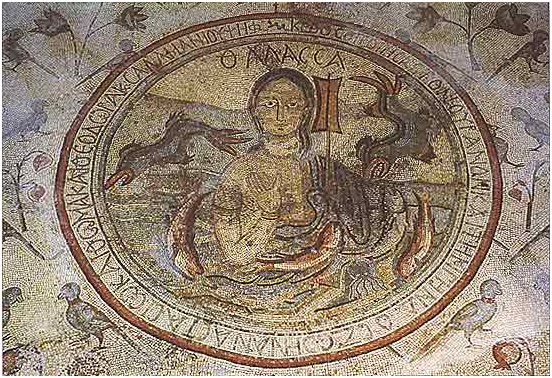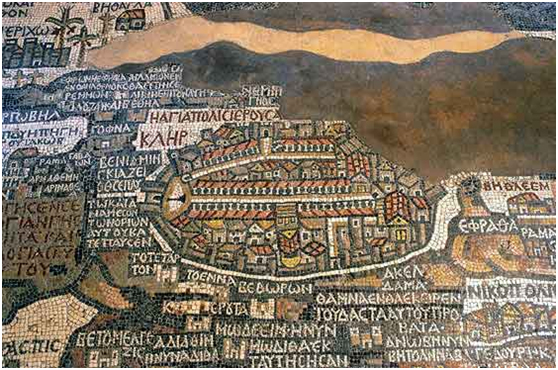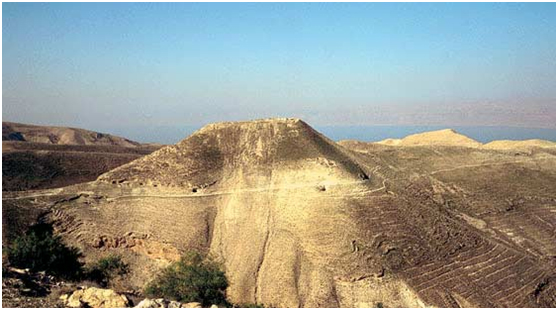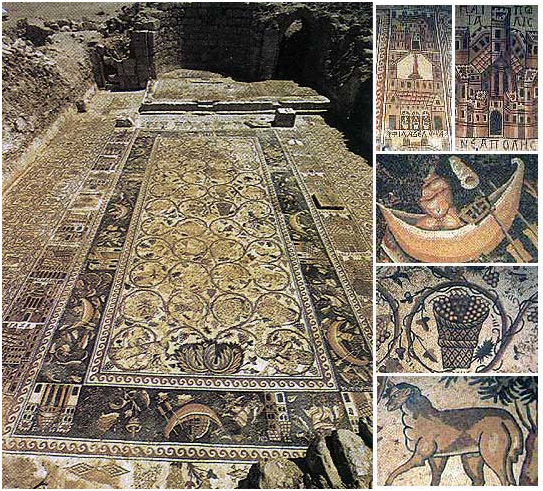Madaba – The City of Mosaics
 Madaba is a typical East Bank town but which differs in one major aspect: underneath almost every house lies a fine Byzantine mosaic. Many of these mosaics have been excavated and are on display in the town’s museum, but it is estimated that many more lie hidden waiting to be discovered. Madaba’s chief attraction is the wonderful 6th-century Byzantine mosaic map showing the entire region from Jordan and Palestine in the north, to Egypt in the south.
Madaba is a typical East Bank town but which differs in one major aspect: underneath almost every house lies a fine Byzantine mosaic. Many of these mosaics have been excavated and are on display in the town’s museum, but it is estimated that many more lie hidden waiting to be discovered. Madaba’s chief attraction is the wonderful 6th-century Byzantine mosaic map showing the entire region from Jordan and Palestine in the north, to Egypt in the south.
Madaba has a long history, dating back further than 1300 BC. It was first mentioned in the Bible as Medeba at the time of the Exodus (Numbers 21,30 ; Joshua 13:9), it was then an Amorite town close to the Moab border, and it changed hands frequently. The Nabataeans governed the city during the 1st century AD. And in the Hellenistic period, under the Romans, it was a flourishing provincial town with temples and colonnaded streets and surrounded by a strong wall.
Under the Byzantines, Madaba became the seat of a bishopric. During this period, and particularly in the 6th century, mosaics were lavished on churches and public and private buildings. Madaba was sacked by the Persians in 614, and its ruin was completed by the earthquake of 747. It stood abandoned for over 1000 years until, around 1880, a group of about 2000 Christians from Kerak settled here. It was they, in the process of rebuilding, who found the mosaics buried under the rubble.
Madaba museum has many mosaics that were originally on the site. Also, mosaics from other locations have been housed in the museum to ensure their preservation. A collection of Byzantine churches as well as ancient Roman remnants and mosaics, make up this spectacular museum which is located near the Mosaics School.
The Mosaic Map of Madaba
 This famous mosaic was designed around 570 AD to decorate the floor of a Byzantine church in Madaba. It is now housed in the Greek Orthodox Church of St. George, which was built in 1896 over the remains of the original Byzantine Church. Only part of the map has been preserved. The map, originally 25 x 5 meters and made of more than 2 million pieces of colored stone tesserae, shows all the biblical sites from the entire region of Jordan and Palestine in the north, to Egypt in the south, and depicting plains, hills, valleys, villages, and many towns and cities.
This famous mosaic was designed around 570 AD to decorate the floor of a Byzantine church in Madaba. It is now housed in the Greek Orthodox Church of St. George, which was built in 1896 over the remains of the original Byzantine Church. Only part of the map has been preserved. The map, originally 25 x 5 meters and made of more than 2 million pieces of colored stone tesserae, shows all the biblical sites from the entire region of Jordan and Palestine in the north, to Egypt in the south, and depicting plains, hills, valleys, villages, and many towns and cities.
It includes a very detailed plan of the holy city of Jerusalem placed at the center of the redeemed acumen: on the left is the north gate from which two colonnaded streets run south. On the straight street through the heart of the city stands the domed Holy Sepulcher. Clearly inscribed above the north and east gates is the legend “Holy City of Jerusalem”.
Machaerus
 Known today as Mukawir, this dramatic hilltop is the traditional site of the execution of John the Baptist (pbuh). It lies less than 20 km southwest of Madaba at the King’s Highway on a stark promontory (720 m), overlooking the Dead Sea and protected on three sides by deep ravines. A fortress was first built here by the Hasmonean ruler Alexander Jannaeus (103-76 BC) to defend Perea against the expansionist Nabataeans.
Known today as Mukawir, this dramatic hilltop is the traditional site of the execution of John the Baptist (pbuh). It lies less than 20 km southwest of Madaba at the King’s Highway on a stark promontory (720 m), overlooking the Dead Sea and protected on three sides by deep ravines. A fortress was first built here by the Hasmonean ruler Alexander Jannaeus (103-76 BC) to defend Perea against the expansionist Nabataeans.
It was restored then by Herod the Great (37-4 BC) who, according to the contemporary historian Josephus, “built a wall round the very summit and erected towers at the corners, each 27.4 m high. In the middle of this enclosure he built a palace, breath-taking in size and beauty”. It was at Machaerus, it is said, that John was imprisoned, and Herodias’ daughter Salome danced and demanded the Baptist’s head on a platter. During the Judaean war many refugees fled from Jerusalem to Machaerus for safety. It was finally destroyed, again by the Romans, in 72 AD.
Umm Arrasas
 The Old and New Testaments mention it, the Romans fortified it, and the local Christians were still embellishing it with Byzantine-style mosaics well over 100 years after the beginning of Muslim Umayyad rule: Kastron Mefaa, modern Umm Arrasas, has a long history to tell.
The Old and New Testaments mention it, the Romans fortified it, and the local Christians were still embellishing it with Byzantine-style mosaics well over 100 years after the beginning of Muslim Umayyad rule: Kastron Mefaa, modern Umm Arrasas, has a long history to tell.
This rectangular walled city, located about 30 km southeast of Madaba, lays in ruins, but several buildings in its eastern part, including churches, a courtyard with a well, staircases and beautifully curved stone arches have been excavated and restored. The Church of St. Stephen with its perfectly preserved and remarkable mosaic floor, the largest in Jordan, contains the images and portraits of 27 Old and New Testament cities of Egypt and of the Holy Land from both east and west of the Jordan River. This church mosaics is since 2004 a UNESCO World Heritage.
Less than 2 km north of the fortified town, the highest standing ancient tower of Jordan: a 15 meter high, Byzantine square tower with no door or inner staircase, thought to be used by early Christian monks looking for solitude.
